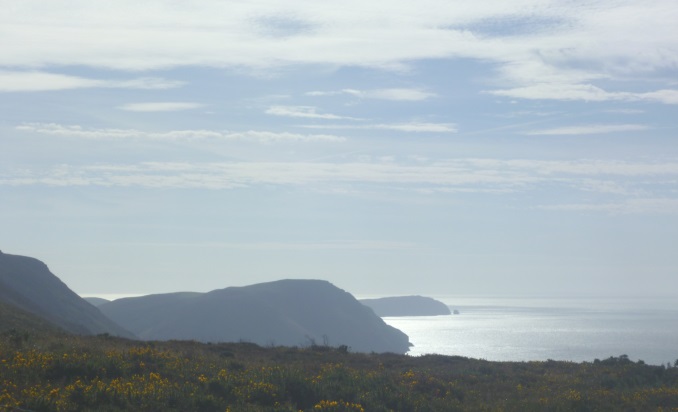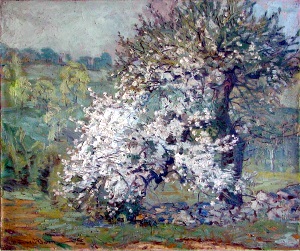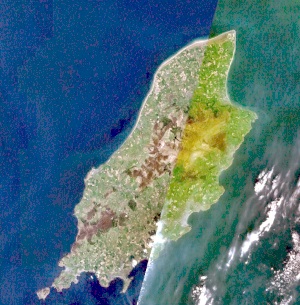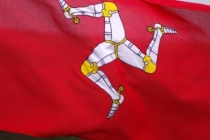Ben Varrey the Manx Mermaid and the story of The Mermaid and the Apple Tree

Isle of Man (Mannin) is located in the north Irish Sea. The Point of Ayre (Manx: Kione ny h-Ayrey) is the northernmost point of the Isle of Man and is just 26 kilometres (16 mi) south of Burrow Head in south-west Scotland. The island comprises 227 square miles (588 square kilometres) and it measures approx. 33 miles long by 13 miles wide. Sometimes described as the Celtic heart of the Irish Sea, the island is not part of the United Kingdom and has its own Government (Tynwald) and language Manx Gaelic. The cultural influences for the island originate from the indigenous Celtic peoples. The Vikings arrived in the Island around 800 AD and a fusion of cultures took place which is still evident in the archaeology, language, place-names and Parliamentary traditions of the island.
The Manx nation has a rich cultural heritage and folklore. The Celtic myths, legends, traditional beliefs, customs, and stories of the Isle of Man (Mannin) have been passed from generation to generation, much of it through oral tradition. The importance of folklore to a nation should not be underestimated. It encompasses the traditions common to that culture and shared by its people. Many entities exist in Manx mythology. Creatures that can rise from the rivers and the sea, emerge from cavernous depths and spring out of rocks. Variations of stories featuring each of these mysterious beings have been told on the Isle of Man for many centuries. Not least of which feature the Ben Varrey, the Manx name for a Mermaid and there is also a male equivalent the Dooinney Marrey.
One such tale of the Ben Varrey and her love of apples is told by Kathleen Killip (1911 - 1991). Amongst her work is ‘St Bridget’s Night: Stories from the Isle of Man.’ Here she tells the story of The Mermaid and the Apple Tree.
The Mermaid and the Apple Tree

A long time ago a fisherman called Juan Caine lived in a thatch cottage on the Isle of Man, right on the edge of the sea. His thatch was as bright as gold and his walls were as white as the winter snow.
When he wasn’t out in his boat he was busy in his fields or his garden where the waves washed up to the tall fuchsia hedge and on stormy days tried to get right in. His pansies and wallflowers and roses grew bright in the sea air. In spring the scent of apple trees floated out over the water and in autumn they were heavy with shiny red apples.
And whether he was digging the garden or milking the black cow, or sowing the corn, or cutting the hay, or mending the nets, Juan was always singing because he was as happy as the day was long.
But sad to say there came an end to all this for one summer Juan got a spell of bad luck at the fishing. Every time he went out to look for the silver herring he came back with an empty boat. And when this happened for a whole summer you may well believe Juan couldn’t sing any more.
One moonlight night he went out to smoke a pipe under the apple trees and listen to the whisper of the wind and the talk of the sea, the way he would maybe find out what kind of weather there would be for the next day’s fishing, when all of a sudden he heard a voice, very low and quiet.

“Juan, is it yourself that’s in?”
“It is. It is. But who’s asking for me at this time of the night at all?”
“Don’t ask who I am. But come over here and answer my questions,” said the voice.
“But I can’t see any person.”
“Over here. By the fuchsia hedge.”
Juan leaned over into the shadows and saw a flash of white and a gleam of gold in the water below.
“I believe it’s the ben varrey I’m talking to,” he said. His mother had always said when he was a small boy that there was a mermaid living down at the edge of the tide.
“I used to be coming here every day Juan, to listen to your singing. Indeed there was nothing I liked better. How is it you’re never giving us a bit of song now at all?”
“Well I’m not feeling much like singing in the times that’s in,” said Juan, and he began to tell how he went out in the boat every day and couldn’t find the herring anywhere.
“Gone off wandering in the seas they are. Nobody knows where to find them…but who am I talking to at all?”
“Never mind that Juan boy, but listen. If I tell you where to find the herring will you promise to sing your songs again?”

“Too true I will! I’ll be happy as the day is long then. But if you can tell me where to find the herring I know you must be the ben varrey.”
Well, the ben varrey told Juan her secret and sure enough the next day he came back with his boat full. Later that night he went out into the garden to thank her.
“And is there anything you would fancy from the garden now,” he asked her. “A few roses maybe…”
“Well, since you mention it Juan,” said the ben varrey, “I’ve often thought I would like to taste an apple from one of your trees. The blossom smells so sweet in spring and then in autumn the apples look all red and shiny, like jewels.”
“You can have as many as you like,” said Juan. And there and then he picked a basket of the best fruit from his trees.
The ben varrey liked the apples so much she often came back for them and you can imagine that from that time on Juan was always lucky at the fishing.
One day he decided to give the ben varrey an apple tree all for herself and he planted one by the garden wall just at the edge of the tide. In spring she could catch the petals of blossom as they floated down, and in autumn she could reach up and gather an apple from her own tree.
All this, as I told you, happened a long time ago and of course Juan’s little house is no more to be seen. But the tree he planted is there today and some people say that on moonlight nights the ben varrey still comes and gathers her apples.
Source: Kathleen Killip from ‘Saint Bridget’s Night: Stories from the Isle of Man’
Content type:
- Manx
Language:
- English






